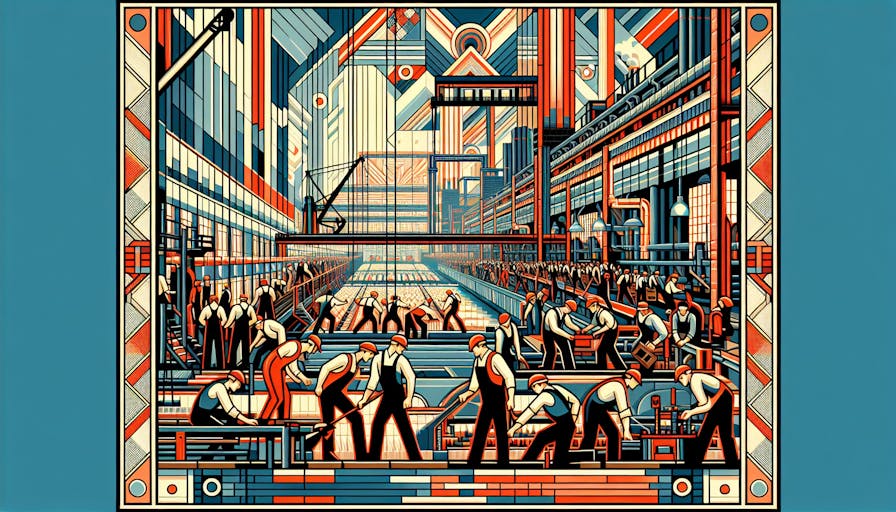Understanding the industrial revolution working conditions
Before delving into the nuances of the Industrial Revolution, it is essential to establish a clear understanding of what this term means and the time period it covers.
Definition and Time Period
The Industrial Revolution is broadly defined as a period of major industrialization that took place during the late 18th and early 19th centuries. It marked a significant transition from manual labor to mechanized manufacturing, transforming agrarian economies into industrial ones.
The term “industrial revolution” describes a historical period in 18th-century Great Britain where the pace of change appeared to speed up. This led to the introduction of an array of new tools and machines that affected labor, production, and resource use. It was a merger of technology with industry that shaped existing sectors of human activity along industrial lines, creating many new industries.
For a detailed timeline of the Industrial Revolution, refer to our industrial revolution timeline.
Regions Affected
The Industrial Revolution initially began in Britain in the late 18th century and spread throughout the world over the following centuries. The innovations and changes brought about during this period had a profound impact on societies around the world, particularly in Europe and the United States.
These regions underwent a fundamental transformation from primarily agrarian societies to industrialized ones, leading to significant changes in their economies, social structures, and working conditions. For a detailed discussion on the effects of the Industrial Revolution, visit our effects of the industrial revolution page.
Understanding the Industrial Revolution and its impact is crucial, as it not only shaped the world as we know it today but also set the stage for future industrial and technological advancements.
Key Characteristics of Industrial Revolution
The Industrial Revolution was a transformative period marked by significant changes and developments in economic, technological, and social facets of society. This section will examine the two key characteristics of the Industrial Revolution: the shift from hand-made to machine-made goods and the growth of cities and transportation.
Shift from Hand-made to Machine-made
The shift from hand-made to machine-made products marked the beginning of the Industrial Revolution (ThoughtCo). This period marked a transition from a rural, agrarian economy to an urban, industrial economy in England during the late 18th and early 19th centuries, characterized by the use of machinery and factories for manufacturing goods.
The rise of factory production and industrial cities resulted in a separation of the home from the workplace, motivating men to leave their families behind for jobs in the city. Women and children were also employed in the textile industry, often working 16 hours per day or longer for very little pay.
This significant shift has massive implications on the industrial revolution working conditions, leading to a new paradigm in labor and production methods.
Growth of Cities and Transportation
The increase in industrialization led to the growth of cities and the need for improved transportation systems in order to move goods and people more efficiently. The development of new transportation technologies, such as canals, roads, and railways, played a significant role in the Industrial Revolution by facilitating the movement of raw materials, finished products, and people.
The emergence of railways as one of the world’s leading industries in the 19th century revolutionized transportation, facilitating the delivery of agricultural produce and manufactured goods. The introduction of steam engines in railway locomotion, with the first steamboat appearing in the early 19th century, played a crucial role in expanding industrial society’s frontiers across Europe, North America, and eventually Asia.
The transportation improvements during the Industrial Revolution not only boosted economic growth but also transformed the social structure of society, impacting where people lived and how they worked. This transition resulted in the growth of cities, factory-based employment, and the emergence of working-class communities in urban areas.
The Industrial Revolution led to the growth of the middle class in society, as skilled workers and professionals emerged alongside factory owners and industrial capitalists, creating a more complex social structure, which you can further explore in our article on effects of the industrial revolution.
These advancements in manufacturing and transportation are quintessential elements in understanding the industrial revolution definition. The profound effects of these changes are still evident in today’s society, shaping our cities, industries, and transportation systems.
Significant Innovations
The Industrial Revolution ushered in a wave of significant innovations. These innovations, particularly in the realm of machinery and production techniques, acted as catalysts, accelerating the pace of the Industrial Revolution. This period saw a marked departure from manual labor to mechanized work, with the steam engine and advancements in textile machinery and iron production playing pivotal roles.
Importance of the Steam Engine
One of the most critical inventions during the Industrial Revolution was the steam engine. Developed to power machinery, trains, ships, and other vehicles, this innovation revolutionized transportation and industry by providing an efficient source of power for various applications.
The steam engine fundamentally changed the way work was done. It enabled factories to operate irrespective of the availability of wind or water power, which were the primary sources of power before the Industrial Revolution. This led to significant improvements in productivity and efficiency, fuelling the growth of industries and cities.
The steam engine also played a crucial role in the development of new transportation technologies. It powered locomotives and steamships, facilitating the movement of raw materials, finished products, and people (ThoughtCo). This helped to further enhance economic activity and catalyzed the transformation of these regions into industrial economies.
Rise of Textile Machinery and Iron Production
The Industrial Revolution also saw significant advancements in textile machinery and iron production processes. These innovations drove the growth of the textile and iron industries, two of the key sectors during this period.
In the textile industry, the introduction of machines like the spinning jenny, spinning mule, and power loom significantly increased production speed and efficiency. These machines allowed for the rapid production of textiles, meeting the growing demand both domestically and internationally.
At the same time, advancements in iron production, such as the introduction of coke smelting, allowed for the mass production of iron. This was a significant development, as iron was a critical material used in machinery, construction, and transportation.
These innovations played a critical role in shaping the Industrial Revolution and its legacy. They not only transformed production processes but also significantly impacted society and the economy. For more insights into the profound changes brought about by the Industrial Revolution, refer to our articles on effects of the industrial revolution and industrial revolution working conditions.
Impact on Society and Economy
The Industrial Revolution was not only a period of technological advancement and economic transformation, but it also brought about significant changes in society and the economic structure. This era, defined by the shift from agrarian to industrial societies, paved the way for the rise of capitalism and the modern consumer culture.
The Industrial Revolution brought about significant social changes. A notable shift was the transition from rural farming communities to urban industrial societies. This transition was sparked by the rise of factories and industrial cities, which drew workers away from their rural homes and into the cities in search of work.
This shift resulted in a clear separation of the home from the workplace, with men leaving their families behind for jobs in the city. Women and children were not exempt from these changes – they were also employed in the textile industry, often working 16 hours per day or longer for very little pay. For more details on the conditions, refer to our content on industrial revolution working conditions.
Furthermore, the Industrial Revolution led to the growth of the middle class in society. Skilled workers and professionals emerged alongside factory owners and industrial capitalists, creating a more complex social structure than had previously existed (Social Effects of the Industrial Revolution).
Rise of Capitalism and Consumer Culture
An important aspect of the industrial revolution is its role in the rise of capitalism. The transition to machine production and the growth of factories paved the way for a new economic system in which goods were mass-produced and sold for profit.
This economic transformation led to the rise of the modern consumer culture we see today. As goods became more readily available and affordable, people began buying and consuming more, leading to a cycle of production and consumption that continues to drive our economy.
By the late 19th and early 20th centuries, Britain, the United States, and other industrialized nations were enacting reform laws to limit some of the worst abuses of the factory system. However, similarly oppressive labor conditions persisted in many parts of the world as their economies industrialized in the 20th and 21st centuries.
The social and economic changes brought about by the Industrial Revolution continue to shape our world today. Understanding these changes provides valuable context for discussions on the effects of the industrial revolution and the causes of the industrial revolution. For a detailed chronology of these changes, you can refer to our industrial revolution timeline.
The Industrial Revolution and Agriculture
As the industrial revolution definition broadens, it’s important to discuss its impact on agriculture. The transition from traditional farming to mechanized and specialized agricultural practices significantly transformed food production and management.
Mechanization and Specialization
The mechanization of agriculture played a crucial role in the industrial revolution. Between 1950 and 2000, mechanization led to a doubling of production on U.S. farms with less than a third of the labor costs. As a result, the share of the U.S. workforce involved in agriculture declined from 41% to 2% over the same period.
Specialization in agriculture also emerged during the industrial revolution, replacing diversified farming with genetically uniform monocultures and animals bred for specific outcomes. This significantly altered the roles of farmers and the production processes involved (Food System Primer).
| Period | Farm Production | Labor Cost | Workforce in Agriculture |
|---|---|---|---|
| 1950 | 100% | 100% | 41% |
| 2000 | 200% | < 33% | 2% |
Impact on Food Production and Management
The impact of the industrial revolution on food production and management was profound. The introduction of synthetic nitrogen fertilizers in the early 1900s significantly contributed to global population growth from 1.6 to 6 billion over the 20th century. Between 1964 and 1976, synthetic and mineral fertilizer applications on U.S. crops nearly doubled (Food System Primer).
Consolidation in agriculture led to a shift towards fewer and larger farms in the U.S., with the average size of farms more than doubling between 1950 and 1997, and the total number of U.S. farms declining from 5.39 million to 1.91 million over the same period (Food System Primer).
| Year | Average Farm Size (acres) | Total Farms |
|---|---|---|
| 1950 | 213 | 5.39 million |
| 1997 | 487 | 1.91 million |
The industrial revolution ushered in new agricultural practices, which significantly transformed food production and management. To understand more about the industrial revolution, you may find our articles on the industrial revolution timeline and the effects of the industrial revolution helpful.








